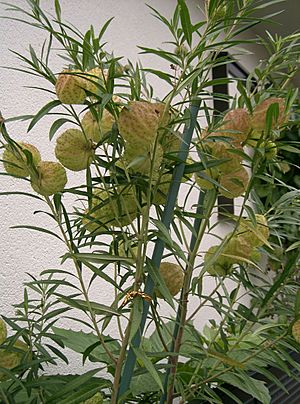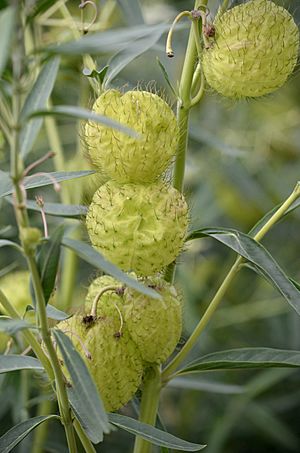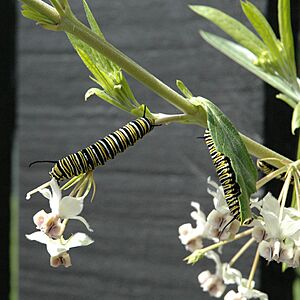Hairy balls facts for kids
Quick facts for kids Hairy balls |
|
|---|---|
 |
|
| Photo of balloonplant with capsules | |
 |
|
| Detail photo of balloonplant capsules | |
| Scientific classification | |
| Genus: |
Gomphocarpus
|
| Species: |
physocarpus
|
| Synonyms | |
|
|
Gomphocarpus physocarpus, often called the balloonplant or swan plant, is a unique type of plant related to the dogbane family. It gets its common names from its interesting, puffy seed pods that look like balloons or even swans. This plant originally comes from southeastern Africa, but it has spread and now grows in many other parts of the world. People often grow it in their gardens because of its unusual appearance.
Contents
What the Balloonplant Looks Like

The balloonplant is a type of small shrub that grows back year after year. It can reach over six feet (about 1.8 meters) tall! This plant blooms during the warmer months. You can often find it growing along roadsides in areas that are 2,800 to 5,000 feet (about 850 to 1,500 meters) above sea level. It likes places with a moderate amount of moisture, sandy soil that drains well, and plenty of sunshine.
The flowers of the balloonplant are small, about 1 centimeter (0.4 inches) across, and have white, hood-like parts. The most famous part of the plant is its fruit, which is a pale green, round, inflated pod. This pod is covered with rough hairs and can grow up to three inches (about 7.6 centimeters) wide. The leaves are light green, long and narrow, usually 3 to 4 inches (7.6 to 10 cm) long and about 1.2 cm (0.5 inches) wide. Inside the pods, the brown seeds have silky tufts that help them float away in the wind.
This plant can easily mix with another similar plant called Gomphocarpus fruticosus. When they mix, they create new plants that have features from both parents.
How the Balloonplant is Used
In some traditional practices, parts of the Gomphocarpus physocarpus plant are used to make special ointments. The seeds are also sometimes used in rituals.
It's important to know that the leaves and stems of the balloonplant produce a milky sap, called latex. This sap can be irritating or toxic if touched or eaten. So, it's always best to be careful and avoid direct contact with the sap.
Balloonplant and Butterflies
The Gomphocarpus physocarpus plant plays a very important role in nature. It is a favorite food source for the caterpillars of Danaus butterflies. This includes the famous monarch butterfly! Monarch caterpillars munch on the leaves of the balloonplant, which helps them grow and get ready to turn into beautiful butterflies.
See also
 In Spanish: Asclepias physocarpa para niños
In Spanish: Asclepias physocarpa para niños

